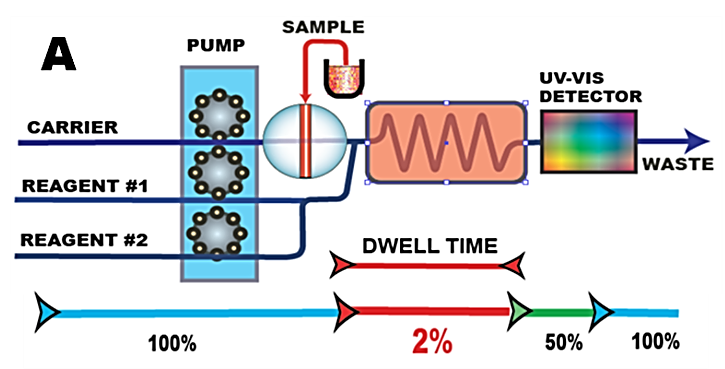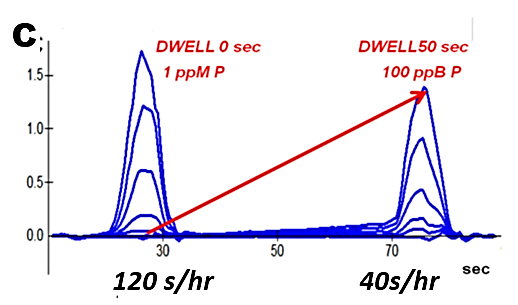2.1.6. Slow down and accelerated flow
Performance of the traditional continuous forward flow technique can be enhanced by a sequence of flowrates designed to optimize individual steps of an assay (A).
 Variable flow rate protocol begins at 100% flow rate designed to flush manifold, followed by very slow 2% flow through heated reactor, followed by medium 50% flow rate at which the peak maximum is measured. The outcome is higher sensitivity of an assay, reduction of the volume of the generated waste, and higher efficiency of steps carried at slow flow dwell time. The variable forward flow method can be viewed as an simple upgrade of existing cFI method, since it can be implemented by using conventional FI setup, that is, as long as the pumps can be programmed to generate desirable flowrates.
Variable flow rate protocol begins at 100% flow rate designed to flush manifold, followed by very slow 2% flow through heated reactor, followed by medium 50% flow rate at which the peak maximum is measured. The outcome is higher sensitivity of an assay, reduction of the volume of the generated waste, and higher efficiency of steps carried at slow flow dwell time. The variable forward flow method can be viewed as an simple upgrade of existing cFI method, since it can be implemented by using conventional FI setup, that is, as long as the pumps can be programmed to generate desirable flowrates.
Phosphate determination can be optimized by fast/slow flow programming (B) and by adjusting the injected sample volume, to accommodate concentration range from 10 to 1000 ppB P and to generate approximately 50% less of waste compared to continuous flow system.
 The flow programming comprises five sections within each assay cycle:
The flow programming comprises five sections within each assay cycle:
- Priming @100%fr for 5 sec
- Sample injection @50% flow rate for 1 sec
- Incubation @2%fr for DWELL sec
- Monitoring @50%fr for 12 sec
- Washout @100% for 6 sec
The high concentration range (C) was run at zero seconds dwell time, while the low concentration range was run using 50 seconds dwell time.
 The overlaid runs obtained at 0 and 50 sec dwell times (C) show enhancement of the sensitivity of the assay when the incubation time was increased by slowing the flow through the reaction coil to 80 µL/min for 50 second interval. Thus, as sampling frequency decreased from 120 s/hr to 40s/hr, the sensitivity of the assay increased almost 10 times, due to longer incubation time. For all assays, the injected sample volume was 300 µL and the flow cell light path was 10 cm long. All manifold tubing was 0.8 mm I.D.
The overlaid runs obtained at 0 and 50 sec dwell times (C) show enhancement of the sensitivity of the assay when the incubation time was increased by slowing the flow through the reaction coil to 80 µL/min for 50 second interval. Thus, as sampling frequency decreased from 120 s/hr to 40s/hr, the sensitivity of the assay increased almost 10 times, due to longer incubation time. For all assays, the injected sample volume was 300 µL and the flow cell light path was 10 cm long. All manifold tubing was 0.8 mm I.D.
Slowing flowrate through gas diffusion module allows the length of gas diffusion module to be reduced from 10 cm to 1 cm, while sensitivity of an assay increased. Applied for ammonia determination this approach can serve as a template for improvement of other gas diffusion techniques.